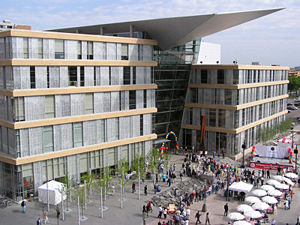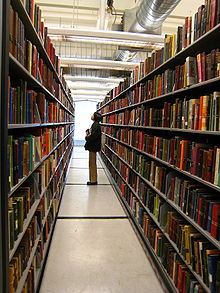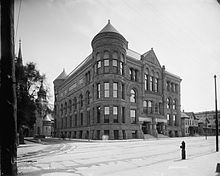- Minneapolis Public Library
-
- For the current library system serving Minneapolis, see Hennepin County Library.
The Minneapolis Public Library and Information Center (MPL) was a library system serving the residents of Minneapolis, Minnesota in the United States. It was founded as the publicly traded Minneapolis Athenæum in 1860 and became a free public library in 1885 founded by T. B. Walker. In 2008, the library was merged into the Hennepin County Library.
The library at the time of its merger with Hennepin County Library in 2008 included a central facility downtown and fourteen branch libraries.[1] Each library also had a staff member who was assigned to local schools to discuss the services available at the library. According to the 2004 board report, the collection numbered about 3.1 million items with about 2.2 million of these housed in the central library.
The Minneapolis Public Library joined the Hennepin County Library under the latter name on January 1, 2008; the last meeting of the Minneapolis Public Library Board of Trustees took place on December 19, 2007.
Unusual for a public library, MPL used the Library of Congress Classification. The oldest materials were cataloged using the Dewey Decimal System; around 1890, the library switched to the early and short-lived Putnam classification system, developed by famed Minneapolis Librarian, Herbert Putnam. He later became Librarian of Congress, and revised his Putnam system into the current Library of Congress methodology.
Contents
Central Library
The Minneapolis Athenaeum was a private library that traded on the stock market. After he moved to Minneapolis, T. B. Walker, who was a stock holder, bought memberships and gave them away, raising the objections of other stock holders. But the technique worked, and soon the city financed a free public library with a one mill property tax.[2]
After Minneapolis voters approved a $140 million package to improve library services on November 7, 2000, many renovation projects were begun. The new Central Library building, designed by Cesar Pelli, along with the Minneapolis firm Architectural Alliance,[3][4] opened to the public on May 20, 2006. At a cost of $250 per square foot, the library features a host of energy-efficient measures, including a roof garden and substantial daylight. While the building was under construction, most services were provided at the interim Central Library Marquette location, located on two floors in Marquette Plaza (formerly the Federal Reserve Bank of Minneapolis). Cost of providing an interim site while the old library was demolished and rebuilt exceeded $10 million.
Until the 2002 closure and demolition of the old central library, the Minneapolis Planetarium Society found its home there, possessing a projector machine literally older than the space age itself (delivered and installed originally in 1954, three years before the launch of Sputnik I). In 2005, the Minnesota Legislature apportioned funding for the inclusion of a planetarium in the new Central Library building. As of May 2007, a 37,000-square-foot (3,400 m2) Minnesota Planetarium Society is planned for the roof of the new building.[5]
Community libraries
The 2002 referendum also included funds to renovate community libraries, supplementing an existing program. The fourteen branches and their renovation status are:
- East Lake Community Library, built 1976, renovated 2007.[6]
- Franklin Community Library, built 1914, renovated 2005.[7]
- Hosmer Community Library, built 1916, renovated 1997.[8]
- Linden Hills Community Library, built 1931, renovated 2002 [9]
- Nokomis Community Library, built 1968. Renovations scheduled to start October 2009.[10]
- North Regional Community Library, built 1971, renovated 2007 [11]
- Northeast Community Library, built 1973, scheduled to be closed for renovation 2008, reopening 2009.[12][13]
- Pierre Bottineau Community Library, built 2003 in the Grain Belt Brewery complex to replace an older storefront library.[14]
- Roosevelt Community Library, built 1927.[15]
- Southeast Community Library, built in 1963.[16]
- Sumner Community Library, built 1915, renovated 2005.[17]
- Walker Community Library, built 1981 to replace the 1915 building still located across the street. Unusually, the Walker is built underground, with only a parking lot and the entrance, a small stub of glass, metal and concrete, above-ground.[18]
- Washburn Community Library, built 1970 renovated 1992.[19]
- Webber Park Community Library, built in 1980.[20]
Improvements are in the works for Nokomis, Northeast, Roosevelt, Southeast, Walker, Washburn, and Webber Park Libraries. Some locations (such as Roosevelt and Nokomis) may be consolidated at one location, and "express" library services along major transportation routes are also a possibility. The framework for the future of the library is a document called Outlook 2010.[21]
The Central, Franklin, East Lake Regional, Roosevelt and Nokomis Libraries are easily accessed from the Hiawatha Line. All locations are either wheelchair-accessible or will be after renovation.
Outlook Twenty Ten
Outlook Twenty Ten: A Discussion Plan to Improve All Minneapolis Community Libraries was a framework for discussion submitted to the Minneapolis Public Library Board of the Minneapolis Public Library System in July, 1999.[22] Outlook Twenty Ten was drafted in anticipation of the people of Minneapolis, Minnesota approving a 140 million dollar referendum in 2000.[23] The framework was submitted to the Minneapolis Public Library Board by Amy Ryan, Chief of Community Libraries. When the referendum was approved in November, 2000, the Library Board turned to the plan. The referendum designated 110 million dollars to creating a new Central Library.[23] The other 30 million dollars were to go to improvements of community libraries. The plan contained a profile of each of the 14 community libraries, including highlights of patron surveys.[22] It also contained at least three suggestions for every community library, entitled Options 'A', 'B', 'C' and onward. The majority of the libraries have been renovated or repaired. An update on the plan came out in 2004, detailing the statuses of the libraries, and presenting a timeline for their completions.[24]
Funding crisis and merger
Despite city funding and generous taxpayer support, the library had suffered from reduced funding from external sources, including the federal government and the State of Minnesota. Hours have been drastically cut and money for acquisitions has sharply declined in the 2000s. Because Minnesota library card holders can borrow from other systems in the state, MPL also faced competition from the Hennepin County Library (HCL), which is remodeling its three regional locations in partnership with other government services. In 2007, the Minneapolis Library Board agreed to pursue a merger with the county system. The Minneapolis Library Board and Minneapolis City Council approved the merger in March 2007, the Hennepin County Board approved the merger in April 2007, and on May 19, 2007 the Minnesota State Legislature approved a bill merging the systems during 2008. The merged system is the Hennepin County Library with 41 locations.[25]
Adamson v. Minneapolis Public Library
Adamson v. Minneapolis Public Library is a civil complaint of 23 March 2003 by a dozen librarians against the library's management for a claimed failure to prevent sexual harassment over many years by library patrons having unlimited use of library computers for accessing pornography. The case followed an EEOC determination on 23 May 2001 that "the Respondent did subject the Charging Party to sexually hostile work environment. This is in violation of Title VII of the Civil Rights Act of 1964, as amended," according to: "EEOC Determination Re: Unrestricted Internet Access Policy of Minneapolis Public Library Creates Sexually Hostile Work Environment."
The case settled when the library agreed to pay them $435,000 and take corrective action to prevent further harassment.
Historic buildings
Many of the buildings built by the Minneapolis Public Library system are listed on the National Register of Historic Places. In some cases, the libraries have been demolished and moved to new, more modern buildings.
- East Lake Community Library, original building at 2916 East Lake Street (since moved to 2727 East Lake Street). The building now houses a liberal political products store.
- Franklin Community Library, current building at 1314 West Franklin Ave.
- Linden Hills Branch Library, current building at 2900 W. 43rd St.
- Minneapolis Public Library, North Branch, original building at 1834 Emerson Ave. N. The North branch was closed not long after the much larger North Regional Library opened at 1315 Lowry Ave. N. The two libraries were about a mile apart, however, and this further exacerbated the unequal library service in the North side as opposed to the South Side of the city.
- Roosevelt Community Library, current building at 4026 28th Ave. S.
- Sumner Branch Library, current building at 611 Emerson Ave. N.
- Thirty-sixth Street Branch Library, current building at 347 E. 36th. St., since renamed to Hosmer Community Library
- Walker Branch Library, original building at 2901 Hennepin Ave. S. (since moved across the street to 2880 Hennepin Avenue) Some had suggested that the Walker library be moved back to its original building as it was vacant and the new underground facility has been dogged by maintenance issues; however the original library building is now occupied by a health club.
Of this list, all but the North Branch library were built under the leadership of the city's head librarian, Gratia Countryman. Franklin, Sumner, and Thirty-Sixth Street were built with funds from Andrew Carnegie.[26]
Directors
There were 11 full-time directors in the history of the MPL. Katherine G. Hadley was the last one serving from 2003 to the merger with Hennepin County Library on January 1, 2008.
- Herbert Putnam (1888–1891)
- James Kendall Hosmer (1892–1904)
- Gratia Countryman (1904–1936)
- Glenn M Lewis (interim) 1936–1937
- Carl Vitz 1937–1945
- Glenn M. Lewis 1946–1957
- Raymond E. Williams 1957–1963
- Margaret M. Mull (interim) 1963–1964
- Ervin J. Gaines 1964–1974
- Mary L. Dyer (interim) 1974–1975
- Joseph Kimbrough 1975–1989
- Susan Goldberg Kent ?–?
- Mary Lawson ?–2002
- Jan Feye-Stukas (interim) 2002–2003
- Katherine G. Hadley 2003–2007
References
- ^ "Hours for All Locations". 2007-02-20. http://mplib.org/hours.asp.
- ^ a b Atwater, Isaac (1893). History of the city of Minneapolis, Minnesota. 1. Munsell via Google Books. pp. 282–299. http://books.google.com/books?id=rj4VAAAAYAAJ.
- ^ "Reader friendly: New library is a beacon for books". http://www.startribune.com/10051/story/427016.html.
- ^ "A Tale of Two Cities". http://www.aia-mn.org/am_magazine/editorial_sept_2006.cfm.
- ^ Minnesota Planetarium official site
- ^ Minneapolis Public Library: East Lake
- ^ Minneapolis Public Library: Franklin Library
- ^ Minneapolis Public Library: Hosmer
- ^ Minneapolis Public Library: Linden Hills
- ^ Minneapolis Public Library: Nokomis
- ^ Minneapolis Public Library: North Regional
- ^ Minneapolis Public Library: Northeast
- ^ RFP for renovation
- ^ Minneapolis Public Library: Pierre Bottineau
- ^ Minneapolis Public Library: Roosevelt Library
- ^ HClib.org
- ^ Minneapolis Public Library: Sumner
- ^ Minneapolis Public Library: Walker
- ^ Minneapolis Public Library: Washburn
- ^ HClib.org
- ^ Outlook 2010 master plan
- ^ a b Ryan, Amy (1999). Outlook Twenty Ten. Minneapolis: Minneapolis Public Library.
- ^ a b "The Minneapolis Public Library Referendum". Minneapolis Public Library. 2007-02-20. http://www.mpls.lib.mn.us/referendum.asp. Retrieved 2008-03-21.
- ^ "Outlook Twenty Ten An Update: Spring 2004". Minneapolis Public Library. 2004. http://www.mpls.lib.mn.us/outlook2010update0504.pdf. Retrieved 2008-03-21.
- ^ "MPL/HCL Consolidation". 2007-12-13. http://www.hclib.org/futureoflibraries/.
- ^ Nord, Mary Ann (2003). The National Register of Historic Places in Minnesota. Minnesota Historical Society. ISBN 0-87351-448-3.
External links
- Minneapolis Public Library (Archive)
- Minneapolis Planetarium
- America's Most Literate Cities
- Pelli Clarke Pelli Architects web site
- Architectural Alliance web site
City of Minneapolis Topics Arts • City Council • Climate • Companies • Demographics • Events and attractions • Geography • History • Law and government • Mayors • Media • Neighborhoods • Notable Minneapolitans • Police & Fire • Library • Schools • Skyscrapers
List of Athenaeums in the United States
Philadelphia | Boston | La Jolla | Minneapolis | Portsmouth, NH | Providence, RI |
Newport, RI | Salem, MA | Saint Johnsbury, VT | Columbia, TN | Pittsfield, MACategories:- César Pelli buildings
- 1885 establishments
- 2008 disestablishments
- Minneapolis Public Library
- Hennepin County Library
Wikimedia Foundation. 2010.





